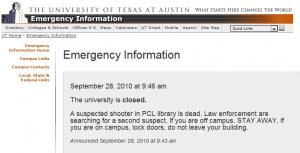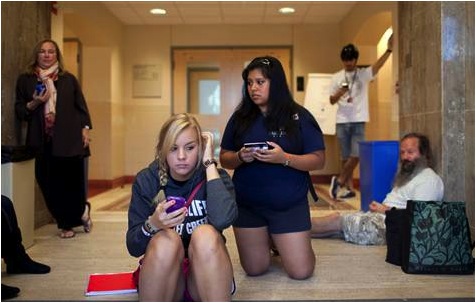- Using Social Media for University Emergency Response 8/23/12
About two years ago, on the morning Sept. 28, 2010, a 19-year-old math major at the University of Texas in Austin arrived on campus with an AK-47 and opened fire. His shooting spree ended in the campus’ Perry-Castañeda Library, where he turned the assault rifle on himself and fired a 12th shot that killed him.
 Timing is everything
Timing is everything
The University of Texas has an emergency notification system for situations like this — as well as official Facebook and Twitter accounts for spreading important information — but the first message wasn’t sent until 20 minutes after the shooter got to campus and opened fire. We all know that every second counts in a situation like this.
In the meantime, the Facebook and Twitter were blowing up with news of the incident and warnings to stay safe…people around the world who are active on social media could have found out about the incident before many those who were actually in danger did!
Miscommunications
There was a lack of official emergency notification, but even worse, the first messages to emerge weren’t official, and miscommunications abounded during those first critical moments. Rumors passed among unofficial parties can foster panic, which can of course lead to even less safe situations.
Though the shooter didn’t actually injure anyone, it’s quite clear he could have, and without proper emergency notification on where the manhunt was taking place, many students could have been in grave danger.

Students Paige Raiczyk, front left, and Veronica Rivera, front right, and other University of Texas students and faculty hold their phones awaiting updated text messages inside the Austin campus' Benedict Hall.
The university’s efforts
Take a look at the University of Texas’ emergency notification from that day on the Thunder Pig blog.
The University of Texas Police Department saw the number of Likes on its Facebook Page skyrocket from 469 on the day of the shooting to more than 10,000 two days later (there are 51,000 students on campus, and there’s no telling how many of the UTPD’s Likes are students).
As of late August 2012, the UTPD’s Facebook Page had 11,783 Likes, and when there’s not an emergency, campus law enforcement stays top of mind by posting other school safety tips, such as instructions on how to double lock your bike, and photos of ordinary campus life and events like the First Responders Bake Sale. This helps ensure that when there is an emergency in the future, students and the community will pay attention.
It’s clear that the University of Texas in Austin and the law enforcement that serves the student body is taking steps to make social media part of its first-response strategies. The UTPD called its first-ever use of social media in issuing emergency alerts a success, but timing is everything in situations like this.
Though the University of Texas in Austin shooting happened years ago, similar incidents have continued to crop up all over the country since then — this is not a problem that’s going away.
Visit our website for more information on how Amatra is working with universities to provide better emergency notification and communication during times of crisis on campus. You can also e-mail the Amatra team with specific questions about your organization.

